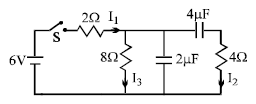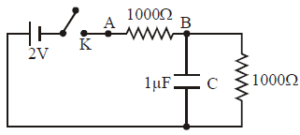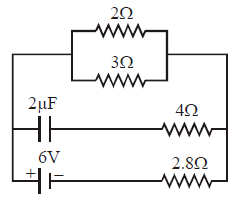In the circuit shown in the figure, the switch S is initially open and the capacitor is initially uncharged. I1, I2 and I3 represent the current in the
resistance 2Ω, 4Ω and 8Ω respectively.

Solution:
Here's the short solution for the circuit:
- Just after the switch is closed:
- The capacitors act as open circuits because they are initially uncharged (capacitor voltage cannot change instantaneously).
- This means no current flows through the branches containing the capacitors.
- Current Distribution:
- The total resistance in the circuit is only the sum of the resistors in the main loop (2Ω + 8Ω), as the branches with capacitors are effectively open.
- Total resistance = .
- Current .
- Branch currents:
- since the capacitor branch is open.
- for the same reason as above.
Final Answer:
- \( I_1 = 0.6 A, \ I_2 = 0\)

